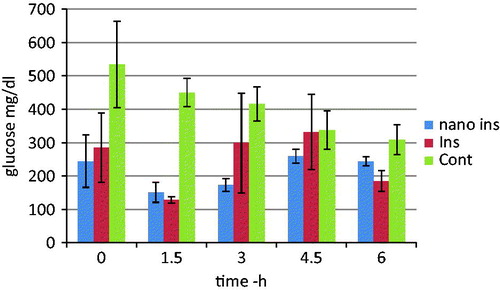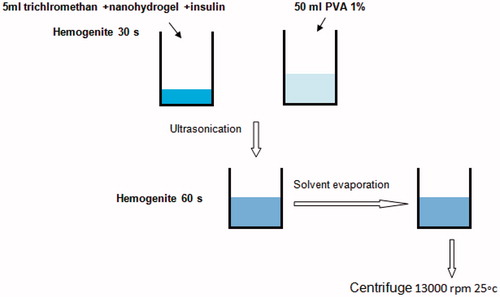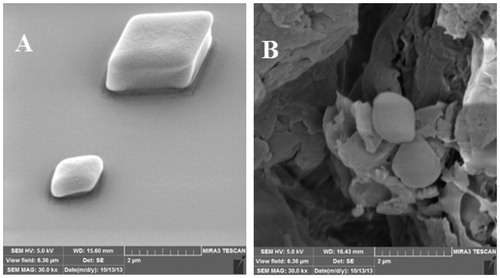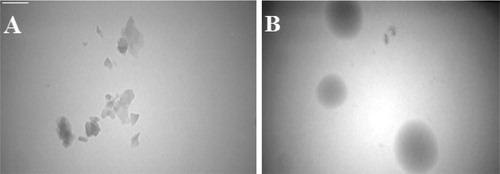Abstract
Background: There are different methods for insulin administration in diabetic patient. Nano-hydrogel is one of the most talented drug carrier for its sensitivity to environmental stimulus.
Methods and results: NIPAAm–MAA–HEM copolymers were synthesized by radical chain reaction. The copolymers were characterized with Scanning electron microscopy (SEM) and Transient electron microscopy (TEM). Copolymers were loaded with regular insulin by modified double emulsion method. Diabetic rats are used for feeding insulin-loaded nanohydrogel. Analysis of the results from the measurement of the amount of blood insulin from the rats blood that received insulin in nanohydrogel loaded form compared with rats that received pure insulin is significantly high, which confirm that insulin has been able to pass from the stomach acid barrier by nanohydrogel and is absorbed from the intestine. Blood sugar levels from tested rats indicate that with increasing amount of insulin, blood sugar levels fall down.
Conclusion: Our study confirms that insulin has been able to pass from the stomach acid barrier by nanohydrogel and be absorbed from the intestine.
Introduction
Diabetes mellitus (DM) is a disorder caused by decreased production of insulin or by decreased ability to use insulin and that is considered by relative insulin deficiency in response to increase in insulin request induced by insulin resistance, leading to increased blood glucose levels (Alejandro et al. Citation2015, Karnoosh-Yamchi et al. Citation2014). Type-1 diabetes comprises those forms of diabetes that are principally due to insulin deficiency. Type-2 diabetes contains those forms that result from a primary defect in insulin resistance (Akhter and Nijhu Citation2012, Davaran et al. Citation2011, Jafari et al. Citation2011). The diabetic foot syndrome includes a number of pathologies, including diabetic neuropathy, Charcot’s neuroarthropathy, peripheral vascular disease, foot ulceration, osteomyelitis, are responsible for extra morbidity and mortality, reduced quality of life, loss of independence, and the potentially avoidable end point, amputation. Subjects with diabetic foot problems are also probable to harbor other associated complications of diabetes such as nephropathy, retinopathy, ischemic heart disease, and cerebrovascular disease (Akhter and Nijhu Citation2012, Assaad-Khalil et al. Citation2015).
Insulin is used to treat diabetes since 1922. There are different methods for insulin administration (Karnoosh-Yamchi et al. Citation2014).
First, Lowman et al. loaded insulin on microspheres of poly methacrylic-ethylene glycol and gave it orally to normal and diabetic pests (Lowman Citation1999). In another study, polymers of acrylic acid–N-isopropyl acrylamide and meta-butyl methacrylic acid with molar ratio of 10:5:85 was used (Peppas Citation2004, Ramkisson-Ganorkar Citation1999). Alginate microparticles produced by emulsification method was used as a carrier for the drug delivery of insulin by Reis et al. (Citation2007). Used nanoparticles protect insulin from stomach acid, but had little biosafety and showed side effects (Karnoosh-Yamchi et al. Citation2014).
Smart polymers are soluble, surface-coated or cross-linked polymers exhibiting comparatively large and sharp physical or chemical changes in response to small physical or chemical stimuli, such as the temperature, pH, solvent composition, addition of special ions, and electric fields (Gupta et al. Citation2006, Sahiner et al. Citation2006). Hydrogels are cross-linked, macromolecular polymer networks occupied in a solvent, synthesized to exhibit large volumetric swelling in response to a variety of environmental stimuli. They are three-dimensional cross-linked polymeric structures that are able to swell in the aqueous environment (Üzüm and Karadağ Citation2007).
Nano-hydrogel is one of the most talented drug carrier for its sensitivity to environmental stimulus (Zhang and Gu Citation2006). Nanogels have recently attracted significant attention in the controlled release technology for diagnostic and therapeutic applications (Argentiere et al. Citation2010).
The main goal of the present research was to provide pH sensitive nanohydrogels containing human insulin and examination the nanohydrogel behavior for oral administration of insulin in diabetic rat.
Materials
Methacrylic acid (MAA) (Merck chemical Co., Germany), Hydroxy ethyl methacrylate (HEMA) (Merck chemical Co., Germany), N-iso propyl acryl amide (NIPAAm) obtained from Acros Organics (NJ), Pure human insulin was purchased from EXIR, Iran Hormone, Alloxan monohydrate (Acros), NaCl (Merck chemical Co., Germany), BPO (Merck chemical Co., Germany), 1,4-Dioxan (Di gung chemical Co., Korea), n-Hexan (Merck chemical Co., Germany), Trichloromethane (Merck chemical Co., Germany), Dichloromethane (Merck chemical Co., Germany), Centrifuge sigma (5000RPM), Centrifuge HEROLAB (13000RPM), Vacuum rotary (er100-pro, China), Sunicator (vp200h, Hiescher, Germany), FT–IR spectrometer instrument (FT–IR, Tensor 27 Bruker), Scanning electron microscopy (SEM, Mira3 tescan 5.0 KV), Transmission electron microscopy (TEM, Zeiss EM10C 80 KV), Rat (Razi Institute, Iran), Ketamine hydrochloride (Germany), Heparinated Capillary (Fisher scientific).
Methods
Nanohydrogel synthesizing
NIPAAm–MAA–HEMA copolymer was synthesized by radical chain reaction with 80:8:12 ratios, respectively. Reaction was carried out in 1, 4-dioxan and under Nitrogen gas-flow. Benzoyl peroxide (0.3 mol % with respect to the monomers) was added as initiator of polymerization. The mixture was magnetically stirred and degassed with nitrogen gas for 30 min. The polymerization was fulfilled at 70 °C for 24 h under nitrogen atmosphere. The synthesized polymers were precipitated using n-Hexane in liquid nitrogen bath. The polymerization yield of the experiment was 86.5%. shows whole scheme protocol of nanohydrogel synthesized.
Insulin loading
Modified double emulsion method was used for loading insulin in the polymers. Poly vinyl alcohol (PVA) was used as stabilizer with 0.1% concentration. First, 100 mg of the synthesized and freeze dried copolymer was dissolved in 5 mL of chloroform. Then, 50 IU (international unit) of insulin as aqueous solution was added in solution and sonicated for 60 s. Then, 50 mL of PVA was added to the mixture and sonicated for 50 s. The mixture was located in vacuum rotary for 30 min for further evaporation of chloroform and loading of insulin and then centrifuged in 13 000 rpm at 25 °C. Loaded polymers were lyophilized and stored in 2–8 °C for further use. shows whole scheme protocol of insulin loading to nanohydrogel (Abbasi et al. Citation2014, Citation2016b, Daraee et al. Citation2016a, Citation2016b, Ebrahimi et al. Citation2016, Mirakabad et al. Citation2016, Nasrabadi et al. Citation2016).
TEM and SEM microscopy and FT-IR spectroscopy
Scanning electron microscopy (SEM) is used for evaluating size and size distribution, and Transient electron microscopy (TEM) is used for evaluating shape and size of the spherical nanohydrogels. The structure of insulin loaded on poly (NIPAAm–MAA– HEMA) nanohydrogels was showed using FT-IR spectroscopy (Aval et al. Citation2016, Chung et al. Citation2016, Ebrahimnezhad et al. Citation2013, Mollazade et al. Citation2013, Nejati-Koshki et al. Citation2013, Pourhassan-Moghaddam et al. Citation2013, Citation2014).
Studies on diabetic rats
Type 1 diabetes mellitus (IDDM) in rats initiated with a single intraperitoneal injection of alloxan 120 mg per kg of body weight and the physiologic serum (NaCl 0.9%) is used as the alloxan solvent (Demerdash et al. Citation2005, Kumar et al. Citation2006, Ragavan and Rishnakumari Citation2006). Increasing blood glucose level between 200 and 300 mg/dl is the criteria of diabetes (Demerdash et al. Citation2005, Kulkarni et al. Citation2002, Ragavan and Rishnakumari Citation2006, Viana et al. Citation2004).
A total of 20 male rats with weigh ∼260–280 g were selected and were made diabetic by injecting intraperitoneally alloxan (120 mg/kg). Three days after injection, diabetics was confirmed by using a glucometer and blood levels above 400 confirmed it (Abbasi et al. Citation2016a, Ahmadi et al. Citation2014, Alimirzalu et al. Citation2014, Alizadeh et al. Citation2014, Citation2016, Davoudi et al. Citation2014, Eatemadi et al. Citation2014, Ghasemali et al. Citation2013, Hosseininasab et al. Citation2014, Kouhi et al. Citation2014).
The rats were randomly divided into three groups. Rats by intraperitoneal injection of ketamine (44 mg/kg) were anesthetized and to control diabetics, a blood sample was taken from the eye by capillary heparinated and then in the order:
Control group were given distilled water by gavage.
Group 1 were fed with nanoparticles containing insulin dissolved in distilled water by gavage equivalent 20 IU/kg (5 IU for each rat with weight average 250 gr). (3 mg of insulin-loaded nanohydrogel containing 5 IU insulin)
Group 2 were fed with pure insulin (20 IU/kg) dissolved in distilled water by gavage.
After gavage, rats were anesthetized by ketamine and the blood sampling was done in each 90 min for 6 h (for four times), blood samples were collected in the 1.5 ml ependorfs and were centrifuged in 4000 rpm for 10 min to separate serum, serum samples were collected in 0.5 ml ependorfs and the amount of insulin and blood glucose levels are measured.
Statistical analysis
Statistical data were performed by student’s t-test on SPSS version16 and charting was performed by Microsoft Excel software 2010 version (Redmond, WA).
Results
The product of synthesized nanohydrogel is in crystal form. This product for subsequent applications could be kept at room temperature or in refrigerator or in freezer. The SEM micrographs of pure PNIPAAm–MAA–HEMA nanohydrogels () and insulin loaded on poly (NIPAAm– MAA–HEMA nanohydrogels () are shown.
The TEM micrographs of pure PNIPAAm–MAA–HEMA nanohydrogels () and insulin loaded on poly (NIPAAm– MAA–HEMA nanohydrogels () are shown.
Also, FT-IR is done for pure PNIPAAm–MAA–HEMA nanohydrogels and insulin loaded on poly (NIPAAm– MAA–HEMA nanohydrogels) for evaluation of loading percent.
Analysis of the obtained results from the measurement of the amount of blood insulin is shown in in this diagram, it is known that insulin in the rats blood that received insulin in nanohydrogel-loaded form compared with rats that received pure insulin is significantly high, that confirm insulin has been able to pass from the stomach acid barrier by nanohydrogel and be absorbed from the intestine.
Figure 5. Column chart from the amount of blood insulin collected in different times (the zero time is related to before gavaging).

Blood sugar levels from tested rats is shown in , which indicate that with increasing amount of insulin, blood sugar levels fall down that are compatible with the experimental findings and also mapped charts show that the extent of absorption of insulin in case connected to the nanohydrogel is increased briefly.
Figure 6. Column chart from the amount of blood glucose collected in different times (the zero time is related to before gavaging).

By comparing the graphs of and is evident that blood sugar levels has come down with insulin increasing, the minor changes are probably the result of the stress caused by the shock of the comatose, repeated injections, blood sampling, and animal fasting during the test time.
Discussion
Our in vivo study shows that attached insulin is synthesized nanohydrogel in 1,4 dioxan solvent without cross linker has lowest release and absorption in the stomach’s acidic environment and most of liberation and absorption in the intestinal environment and this is consistent of Peppas and Ramkisson Ganorkar works that in study were used three acrylic acid polymers, n isopropyl acrylic amide, and butyl meta acrylic acid with 10: 5: 85 molar ratio, the result showed that insulin in the acidic environment of the stomach has the least releasing while in pH = 7/4 insulin releasing done well (Peppas Citation2004, Ramkisson-Ganorkar Citation1999).
The results obtained from the measurement of the amount of rat insulin and blood sugar levels shows that by increasing the amount of insulin or blood sugar levels come down that are consistent with the experimental findings. Because the groups classification was carried out completely random and blood glucose in rats between 200 and 600, and due to this that the average of blood glucose and insulin in rats of each group are calculated and statistical analysis was performed on average, so perhaps there are rats in the control group, which have higher blood sugar in control group and has the same reason.
Analysis of the results show as well as that the extent of absorption of insulin in case connected to the nanohydrogel increase, this work would alter with results of Lowman et al, that first they were loaded with insulin on poly-ethylene glycol and Methacrylic microspheres and were gave orally to diabetic and healthy rats, in this study it was observed that in the acidic environment of the stomach because of the formation of intermolecular polymer complex and trapping insulin inside the polymer molecular network, and trapped insulin was preserved from proteolytic analyses and in neutral and alkaline intestinal environments this complex breaks down and medicine can be released (Lowman Citation1999).
Conclusions
Our main goal in this study is to provide pH sensitive Nanohydrogel from N- iso propyl polyacrylamide + Meta-acrylic acid + Hydroxyethyl methacrylate in 1, 4 Dioxane solvent without cross-linker addition and load the human pure insulin by modified dubbed emulsion and gavage it for diabetic rats and measuring plasma insulin and glucose levels at specified intervals.
Acknowledgements
The authors thank Department of Medical Nanotechnology, Faculty of Advanced Medical Science of Tabriz University for all supports provided. This work was funded by 2013 Drug Applied Research Center Grant.
Disclosure statement
The authors declare that they have no competing interests.
Funding
This work was funded by 2013 Drug Applied Research Center Grant.
References
- Abbasi E, Akbarzadeh A, Kouhi M, Milani M. 2016a. Graphene: synthesis, bio-applications, and properties. Artif Cells Nanomed Biotechnol. 44:150–156.
- Abbasi E, Milani M, Aval SF, Kouhi M, Akbarzadeh A, Nasrabadi HT. et al. 2016b. Silver nanoparticles: synthesis methods, bio-applications and properties. Crit Rev Microbiol. 42:173–180.
- Abbasi E, Aval SF, Akbarzadeh A, Milani M, Nasrabadi HT, Hanifepour Y, Nejati-Koshki K, Pashaei-Asl R. 2014. Dendrimers: synthesis, applications, and properties. Nanoscale Res Lett. 9:247.
- Ahmadi A, Shirazi H, Pourbagher N, Akbarzadeh A, Omidfar K. 2014. An electrochemical immunosensor for digoxin using core-shell gold coated magnetic nanoparticles as labels. Mol Biol Rep. 41:1659–1668.
- Akhter DT, Nijhu RS. 2012. Diabetes mellitus: a journey of insulin. Int Curr Pharm J. 1:32–42.
- Alejandro EU, Gregg B, Blandino-Rosano M, Cras-Méneur C, Bernal-Mizrachi E. 2015. Natural history of β-cell adaptation and failure in type 2 diabetes. Mol Aspects Med. 42:19--41
- Alimirzalu S, Akbarzadeh A, Abbasian M, Alimohammadi S, Davaran S, Hanifehpour Y, Samiei M, Joo SW. 2014. Synthesis and study of physicochemical characteristics of Fe3O4 magnetic nanocomposites based on poly (Nisopropylacrylamide) for anti-cancer drugs delivery. Asian Pac J Cancer Prev. 15:49–54.
- Alizadeh E, Akbarzadeh A, Zarghami N, Eslaminejad MB, Hashemzadeh S, Nejati-Koshki K. 2014. Up-regulation of liver enriched transcription factors (HNF4a and HNF6) and liver specific MicroRNA (miR-122) by inhibition of Let-7b in mesenchymal stem cells. Chem Biol Drug Des. 85:600–608.
- Alizadeh E, Eslaminejad MB, Akbarzadeh A, Sadeghi Z, Abasi M, Herizchi R, Zarghami N. 2016 Feb. Upregulation of MiR-122 via trichostatin a treatments in hepatocyte-like cells derived from mesenchymal stem cells. Chem Biol Drug Des. 87:296–305.
- Argentiere S, Blasi L, Ciccarella G, Barbarella G, Cingolani R, Gigli G. 2010. Nanogels of poly (acrylic acid): uptake and release behavior with fluorescent oligothiophene-labeled bovine serum albumin. J Appl Polym Sci. 116:2808–2815.
- Assaad-Khalil SH, Zaki A, Abdel Rehim A, Megallaa MH, Gaber N, Gamal H, Rohoma KH. 2015. Prevalence of diabetic foot disorders and related risk factors among Egyptian subjects with diabetes. Prim Care Diab. 9:297--303
- Aval SF, Akbarzadeh A, Yamchi MR, Zarghami F, Nejati-Koshki K, Zarghami N. 2016. Gene silencing effect of SiRNA-magnetic modified with biodegradable copolymer nanoparticles on hTERT gene expression in lung cancer cell line. Artif Cells Nanomed Biotechnol. 44:188–193.
- Chung J-H, Kim YK, Kim K-H, Kwon T-Y, Vaezmomeni SZ, Samiei M, et al. 2016. Synthesis, characterization, biocompatibility of hydroxyapatite-natural polymers nanocomposites for dentistry applications. Artif Cells Nanomed Biotechnol. 44:277–284.
- Daraee H, Eatemadi A, Abbasi E, Aval SF, Kouhi M, Akbarzadeh A. 2016a. Application of gold nanoparticles in biomedical and drug delivery. Artif Cells Nanomed Biotechnol. 44:410–422.
- Daraee H, Etemadi A, Kouhi M, Alimirzalu S, Akbarzadeh A. 2016b. Application of liposomes in medicine and drug delivery. Artif Cells Nanomed Biotechnol. 44:381–391.
- Davaran S, Jafari B, Rafie F. 2011. Pharmaceutical sciences, oral insulin: a review on its current condition and future aspects. Pharm Sci. 17:151–162.
- Davoudi Z, Akbarzadeh A, Rahmatiyamchi Ali Akbar Movassaghpour M, Alipour M, Nejati-Koshki K, Sadeghi Z, Dariushnejad H, Zarghami N. 2014. Molecular target therapy of AKT and NF-kB signaling pathways and multidrug resistance by specific cell penetrating inhibitor peptides in HL-60 cells. Asian Pac J Cancer Prev. 15:4353.
- Demerdash E, Yousef FM, Abou MI, Naga NI. 2005. Biochemical study on the hypoglycemic effects of onion and garlic in alloxan-induced diabetic rats. Food Chem Toxicol. 43:57–63.
- Eatemadi A, Daraee H, Karimkhanloo H, Kouhi M, Zarghami N, Akbarzadeh A, Hanifehpour Y, Joo SW. 2014. Carbon nanotubes: properties, synthesis, purification, and medical applications. Nanoscale Res Lett. 9:1–13.
- Ebrahimi E, Abbasi E, Akbarzadeh A, Khandaghi AA, Davaran S. 2016. Novel drug delivery system based on doxorubicin-encapsulated magnetic nanoparticles modified with PLGA-PEG1000 copolymer. Artif Cells Nanomed Biotechnol. 44:290–297.
- Ebrahimnezhad Z, Zarghami N, Keyhani M, Amirsaadat S, Akbarzadeh A, Rahmati M, Taheri ZM, Nejati-Koshki K. 2013. Inhibition of hTERT gene expression by silibinin-loaded PLGA-PEG-Fe3O4 in T47D breast cancer cell line. Bioimpacts. 3:67–74.
- Ghasemali S, Nejati-Koshki K, Akbarzadeh A, Tafsiri E, Zarghami N, Rahmati-Yamchi M, et al. 2013. Study of inhibitory effect of β-cyclodextrin-helenalincomplex on HTERT gene expression in T47D breast cancer cell line by real timequantitative PCR (q-PCR). Asian Pac J Cancer Prev. 14:6949–6953.
- Gupta S, Kuckling D, Kretschmer K, Choudhary V, Rgen Adler H. 2006. Synthesis and characterization of stimuli-sensitive microand nanohydrogels based on photocrosslinkable poly(dimethylaminoethyl methacrylate). Colloid Polym Sci. 284:1121--1129
- Hosseininasab S, Pashaei‐Asl R, Khandaghi AA, Nasrabadi HT, Nejati‐Koshki K, Akbarzadeh A, et al. 2014. Synthesis, characterization, and In vitro studies of PLGA‐PEG nanoparticles for oral Insulin delivery. Chem Biol Drug Des. 84:307–315.
- Jafari B, Rafie F, Davaran S. 2011. Preparation and characterization of a novel smart polymeric hydrogel for drug delivery of insulin. Bioimpacts. 1:135–143.
- Karnoosh-Yamchi J, Mobasseri M, Akbarzadeh A, Davaran S, Ostad-Rahimi A, Hamishehkar H, et al. 2014. Preparation of pH sensitive insulin-loaded nano hydrogels and evaluation of insulin releasing in different pH conditions. Mol Biol Rep. 41:6705–6712.
- Kouhi M, Vahedi A, Akbarzadeh A, Hanifehpour Y, Joo S W. 2014. Investigation of quadratic electro-optic effects and electro absorption process in GaN/AlGaN spherical quantum dot. Nanoscale Res Lett. 9:131–136.
- Kulkarni J, Metha A, Santani D, Goyal R. 2002. Effects of chronic treatment with cromakalim and glibenclamide in alloxan-induced diabetic rats. Pharmacol Res. 46:101–105.
- Kumar GP, Arulselvan P, Kumar DS, Subramanian SP. 2006. Anti-diabetic activity of fruits of Terminalia chebula on streptozotocin induced diabetic rats. J Health Sci. 52:283–291.
- Lowman AM. 1999. Oral delivery of insulin using pH-responsive complexation gels. J Pharm Sci. 88:933–937.
- Mirakabad FST, Akbarzadeh A, Milani M, Zarghami N, Taheri-Anganeh M, Zeighamian V, Badrzadeh F, Rahmati-Yamchi M. 2016. A Comparison between the cytotoxic effects of pure curcumin and curcumin-loaded PLGA-PEG nanoparticles on the MCF-7 human breast cancer cell line. Artif Cells Nanomed Biotechnol. 44:423–430.
- Mollazade M, Nejati-Koshki K, Akbarzadeh A, Hanifehpour Y, Zarghami N, Joo S W. 2013. PAMAM dendrimers arugment inhibitory effect of curcumin on cancer cell proliferation: possible inhibition of telomerase. Asian Pac J Cancer Prev. 14:6925–6928.
- Nasrabadi HT, Abbasi E, Davaran S, Kouhi M, Akbarzadeh A. 2016. Bimetallic nanoparticles: preparation, properties, and biomedical applications. Artif Cells Nanomed Biotechnol. 44:376–380.
- Nejati-Koshki K, Akbarzadeh A, pourhasan-Moghadam M, Joo SW. 2013. Inhibition of leptin and leptin receptor gene expression by silibinin- curcumin combination. Asian Pac J Cancer Prev. 14:6595–6599.
- Peppas NA. 2004. Devices based on intelligent biopolymers for oral protein delivery. Int J Pharm. 277:11–17.
- Pourhassan-Moghaddam M, Rahmati-Yamchi M, Akbarzadeh A, Daraee H, Nejati-Koshki K, Hanifehpour Y, Joo SW. 2013. Protein detection through different platforms of immuno-loop-mediated isothermal amplification. Nanoscale Res Lett. 8:485.
- Pourhassan-Moghaddam M, Zarghami N, Mohsenifar A, Rahmati-Yamchi M, Gholizadeh D, Akbarzadeh A, de la Guardia M, Nejati-Koshki K. 2014. Watercress-based gold nanoparticles: biosynthesis, mechanism of formation and study of their biocompatibility in vitro. IET Digital Library. 9:345–350.
- Ragavan B, Rishnakumari S. 2006. Antidiabetic effect of T. arjuna bark extract in alloxan induced diabetic rats. Indian J Clin Biochem. 21:123–128.
- Ramkisson-Ganorkar C. 1999. Modulating insulin release profile from pH/thermosensitive polymeric beads through polymer molecular weight. J Control Release. 59:287–298.
- Reis CP, Ribeiro AJ, Neufeld RJ, Veiga F. 2007. Alginate microparticles as novel carrier for oral insulin delivery. J Biotechnol Bioeng. 96:97.
- Sahiner N, Godbey WT, McPherson GL, John VT. 2006. Microgel, nanogel and hydrogel–hydrogel semi-IPN composites for biomedical applications: synthesis and characterization. Colloid Polym Sci. 284:1121–1129.
- Üzüm ÖB, Karadağ E. 2007. Swelling characterization of poly (acrylamide-co-N-vinylimidazole) hydrogels crosslinked by TMPTA and semi-IPN’s with PEG. J Polym Res. 14:483–488.
- Viana GS, Medeiros AC, Lacerda AM, Leal LK, Vale TG, Matos FJ. 2004. Hypoglycemic and antilipemic effects of the aqueous extract from Cissus sicyoides. BMC Pharmacol. 4:9.
- Zhang J, Gu YQ. 2006. Characterization of Target Effect of Nano-Hydrogel by near-Infrared Fluorescent Quantum Dots. Nanjing: IEEE Conference Publishing, pp. 42–45.





